ECC: Passenger Counting in the Elevator Using Commodity WiFi
Abstract
:1. Introduction
- First, this paper theoretically analyzes and verifies the monotonic relationship between the variation of CSI and the passenger number. The analysis results suggest that the variation of CSI is sensitive to crowd influences, which can be used for passenger counting.
- Secondly, this paper implements the signal pre-treatment process by CSI segmentation, sub-carrier decorrelation, and noise reduction. In particular, this paper proposes a short-time local detection principal component analysis (SLD-PCA) algorithm to decorrelate the CSI streams quickly. SLD-PCA can effectively extract the principal components from all the CSI sub-carriers while maintaining the CSI’s local structure.
- Thirdly, this paper proposes the time-varying spectrum (TVS) feature that adopts radar detection schemes, which can maximally reveal the relationship between the passenger number and variation of CSI by calculating the energy variation of CSI attenuation in a short time. To improve the estimation accuracy, ECC also extracts the average of amplitude (AOA), and percentage of non-zero elements (PEM) features to construct a multi-dimensional feature as an indicator of relationship variation. Then, the passenger counting is implemented by the Random Forest (RF) classifier, for the local optimization problem introduced by the small dataset has been solved by expanding the dataset through data segmentation.
- Finally, the ECC scheme is implemented with commercial off-the-shelf (COTS) 802.11n devices (Atheros 9300 NICs), then it is evaluated with real-world experiments. Extensive results prove that ECC can effectively estimate the passenger number in the elevator, which can be applied to guide the adjustment of the elevator counterweight.
2. Theoretical Analysis
2.1. The Variation of CSI with the Passenger Number
2.2. Major Challenge
3. Materials and Methods
3.1. System Design
3.2. CSI Segmentation
3.3. Sub-Carrier Decorrelation by SLD-PCA
3.4. Noise Reduction
3.5. Multi-Dimensional Feature Extraction
3.5.1. Amplitude Feature
3.5.2. Spectral Feature
3.5.3. Metric Feature
3.6. Passenger Counting
3.7. Passenger Flow Rate Statistics
4. Results
4.1. Experiments Setup
4.2. Performance Comparison of Different Classifiers
4.3. Impact of Different Feature Dimensions
4.4. Impact of Different Scenes
4.5. Impact of Human Factors
4.6. The Resolution of Passenger Counting
4.7. Impact of Device Layouts
4.8. Precision Comparison of Passenger Flow Rate Statistics
4.9. Comparison with Other Approaches
4.10. System Overhead
5. Discussion
- A general way of device deployment is required to make sure of WiFi signal coverage and the verification of our system in more types of elevator environments. In the experiments, the device was deployed in positions where it could achieve maximum coverage. However, it is impossible to deploy these devices inside an elevator in an actual environment. In addition, the materials and structures of some elevators are different, which will lead to differences in the mathematical relationship between the variation of CSI and the crowd number. The variation of the features may also be different in different cases.
- In the experiments, the testers are relatively static, but people usually perform some small activities, such as raising their hand, touching their nose, turning around or talking to each other, etc. These activities may affect the strength and path number of signal propagation that may have different effects on the system.
- The researchers first consider using a smaller alternative hardware device, which can be deployed on the top of the elevator, like a camera, without affecting the normal use of the elevator. Then, the device number and the deployment will be adjusted according to the different elevators and verify the system performance.
- More CSI propagation path information (e.g., the phase, etc.) will be introduced into the multi-dimensional feature to improve the resolution of the crowd when the CSI is interfered with by human activities, thereby improving the estimation accuracy and strengthening the practical applicability of the system.
6. Conclusions
Author Contributions
Funding
Institutional Review Board Statement
Informed Consent Statement
Data Availability Statement
Conflicts of Interest
Abbreviations
| CSI | channel state information |
| GDPR | general data protection regulation |
| OFDM | orthogonal frequency division multiplexing |
| COTS | commercial off-the-shelf |
| PCs | principal components |
| AOA | average of amplitude |
| TVS | time-varying spectrum |
| PEM | percentage of non-zero elements |
| WT | wavelet transform |
| SLD-PCA | short-time local detection principal component analysis |
| LPP | locality preserving projection |
| CAV | capture variance |
| WCCDA | wavelet coefficient correlation de-noising algorithm |
| DWT | discrete wavelet transform |
| STFT | short-time Fourier transform |
| PBC | power burst curve |
| MIMO | multiple-input multiple-output |
| RF | random forest |
| DT | decision tree |
| SVM | support vector machine |
| CDF | cumulative distribution function |
References
- Zheng, B. Intelligent Fault Diagnosis of Key Mechanical Components for Elevator. In Proceedings of the 2021 CAA Symposium on Fault Detection, Supervision, and Safety for Technical Processes (SAFEPROCESS), Chengdu, China, 17–18 December 2021; pp. 1–3. [Google Scholar]
- Zhang, Y.; Feng, S.; Chen, J.; Niu, K. Research on automatic test system of elevator upward braking check. In Proceedings of the Sixth International Conference on Electromechanical Control Technology and Transportation (ICECTT 2021), Zhuhai, China, 14–15 January 2022; Volume 12081, pp. 375–379. [Google Scholar]
- Zhang, X.; Zubair, M.U. Extending the useful life of elevators through appropriate maintenance strategies. J. Build. Eng. 2022, 51, 104347. [Google Scholar] [CrossRef]
- Gurudath, B.; Kumawat, K.K.; Tejaswi, V.; Sondar, P.R.; Rakshan Kumar, J.; Hegde, S.R. Failure Analysis of a Bucket Elevator Shaft. J. Fail. Anal. Prev. 2021, 21, 563–569. [Google Scholar] [CrossRef]
- Tzou, H.; Schiff, A. Structural dynamics of elevator counterweight systems and evaluation of passive constraint. J. Struct. Eng. 1988, 114, 783–803. [Google Scholar] [CrossRef]
- Delussu, R.; Putzu, L.; Fumera, G. Scene-specific crowd counting using synthetic training images. Pattern Recognit. 2022, 124, 108484. [Google Scholar] [CrossRef]
- Lin, S.F.; Chen, J.Y.; Chao, H.X. Estimation of number of people in crowded scenes using perspective transformation. IEEE Trans. Syst. Man Cybern. Part A 2001, 31, 645–654. [Google Scholar]
- Nichols, J.D.; Bailey, L.L.; O’Connell, A.F., Jr.; Talancy, N.W.; Campbell Grant, E.H.; Gilbert, A.T.; Annand, E.M.; Husband, T.P.; Hines, J.E. Multi-scale occupancy estimation and modelling using multiple detection methods. J. Appl. Ecol. 2008, 45, 1321–1329. [Google Scholar] [CrossRef]
- Wang, Y.; Ma, Z.; Wei, X.; Zheng, S.; Wang, Y.; Hong, X. Eccnas: Efficient crowd counting neural architecture search. ACM Trans. Multimed. Comput. Commun. Appl. TOMM 2022, 18, 1–19. [Google Scholar] [CrossRef]
- Zhang, Y.; Zhou, D.; Chen, S.; Gao, S.; Ma, Y.S. Single-Image Crowd Counting via Multi-Column Convolutional Neural Network. In Proceedings of the 2016 IEEE Conference on Computer Vision and Pattern Recognition (CVPR), Las Vegas, NV, USA, 27–30 June 2016; pp. 589–597. [Google Scholar]
- General Data Protection Regulation. Regulation (EU) 2016/679 of the European Parliament and of the Council. Regulation 2016, 679, 2016. [Google Scholar]
- Wirz, M.; Franke, T.; Roggen, D.; Mitleton-Kelly, E.; Lukowicz, P.; Tröster, G. Probing crowd density through smartphones in city-scale mass gatherings. EPJ Data Sci. 2013, 2, 5. [Google Scholar] [CrossRef] [Green Version]
- Chen, M.; Yang, X.; Jin, Y.; Zhou, M. Dynamic Time Warping Based Passive Crowd Counting Using WiFi Received Signal Strength. In Proceedings of the International Conference on Artificial Intelligence and Security, Dublin, Ireland, 19–23 July 2021; pp. 667–677. [Google Scholar]
- Ding, H.; Han, J.; Liu, A.X.; Zhao, J.; Yang, P.; Xi, W.; Jiang, Z. Human object estimation via backscattered radio frequency signal. In Proceedings of the 2015 IEEE Conference on Computer Communications (INFOCOM), Kowloon, Hong Kong, 26 April–1 May 2015; pp. 1652–1660. [Google Scholar]
- More, S.S.; Pathak, G.; Panchal, S.; Patil, M. RFID-Based Railway Crowd Prediction and Revenue Analysis. In Data Intelligence and Cognitive Informatics; Springer: Singapore, 2021; pp. 97–109. [Google Scholar]
- Zou, H.; Jiang, H.; Luo, Y.; Zhu, J.; Lu, X.; Xie, L. Bluedetect: An ibeacon-enabled scheme for accurate and energy-efficient indoor-outdoor detection and seamless location-based service. Sensors 2016, 16, 268. [Google Scholar] [CrossRef] [PubMed] [Green Version]
- Thati, R.P.; Dhadwal, A.S.; Kumar, P. A novel multi-modal depression detection approach based on mobile crowd sensing and task-based mechanisms. Multimed. Tools Appl. 2022, 1–34. [Google Scholar] [CrossRef] [PubMed]
- Sikdar, A.; Zheng, Y.F.; Xuan, D. An iterative clustering algorithm for classification of object motion direction using infrared sensor array. In Proceedings of the 2015 IEEE International Conference on Technologies for Practical Robot Applications (TePRA), Woburn, MA, USA, 11–12 May 2015; pp. 1–6. [Google Scholar]
- Choi, J.W.; Quan, X.; Cho, S.H. Bi-Directional Passing People Counting System Based on IR-UWB Radar Sensors. IEEE Internet Things J. 2018, 5, 512–522. [Google Scholar] [CrossRef]
- Li, C.; Tanghe, E.; Fontaine, J.; Martens, L.; Romme, J.; Singh, G.; De Poorter, E.; Joseph, W. Multi-Static UWB Radar-based Passive Human Tracking Using COTS Devices. IEEE Antennas Wirel. Propag. Lett. 2022, 21, 695–699. [Google Scholar] [CrossRef]
- Beltran, A.; Erickson, V.L.; Cerpa, A.E. Thermosense: Occupancy thermal based sensing for hvac control. In Proceedings of the 5th ACM Workshop on Embedded Systems For Energy-Efficient Buildings, Roma, Italy, 11–15 November 2013; pp. 1–8. [Google Scholar]
- Mehmood, U.; Moser, I.; Jayaraman, P.P.; Banerjee, A. Occupancy Estimation using WiFi: A Case Study for Counting Passengers on Busses. In Proceedings of the 2019 IEEE 5th World Forum on Internet of Things (WF-IoT), Limerick, Ireland, 15–18 April 2019; pp. 165–170. [Google Scholar]
- Zou, H.; Zhou, Y.; Yang, J.; Gu, W.; Xie, L.; Spanos, C. Freecount: Device-free crowd counting with commodity wifi. In Proceedings of the GLOBECOM 2017—2017 IEEE Global Communications Conference, Singapore, 4–8 December 2017; pp. 1–6. [Google Scholar]
- Guo, X.; Liu, B.; Shi, C.; Liu, H.; Chen, Y.; Chuah, M.C. WiFi-enabled smart human dynamics monitoring. In Proceedings of the 15th ACM Conference on Embedded Network Sensor Systems, Delft, The Netherlands, 6–8 November 2017; pp. 1–13. [Google Scholar]
- Depatla, S.; Mostofi, Y. Crowd Counting Through Walls Using WiFi. In Proceedings of the 2018 IEEE International Conference on Pervasive Computing and Communications (PerCom), Athens, Greece, 19–23 March 2018; pp. 1–10. [Google Scholar]
- Yang, Y.; Cao, J.; Liu, X.; Liu, X. Wi-Count: Passing People Counting with COTS WiFi Devices. In Proceedings of the 2018 27th International Conference on Computer Communication and Networks (ICCCN), Hangzhou, China, 30 July–2 August 2018; pp. 1–9. [Google Scholar]
- Wang, W.; Liu, A.X.; Shahzad, M.; Ling, K.; Lu, S. Understanding and modeling of wifi signal based human activity recognition. In Proceedings of the 21st Annual International Conference on Mobile Computing and Networking, Paris, France, 7–11 September 2015; pp. 65–76. [Google Scholar]
- Guo, S. Electrodynamics, 3rd ed.; China Higher Education Press: Beijing, China, 1997. [Google Scholar]
- Xi, W.; Zhao, J.; Li, X.; Zhao, K.; Tang, S.; Liu, X.; Jiang, Z. Electronic frog eye: Counting crowd using WiFi. In Proceedings of the IEEE INFOCOM 2014—IEEE Conference on Computer Communications, Toronto, ON, Canada, 27 April–2 May 2014; pp. 361–369. [Google Scholar]
- Palipana, S.; Rojas, D.; Agrawal, P.; Pesch, D. FallDeFi: Ubiquitous fall detection using commodity Wi-Fi devices. Proc. ACM Interact. Mob. Wearable Ubiquitous Technol. 2018, 1, 155. [Google Scholar] [CrossRef]
- Shlens, J. A Tutorial on Principal Component Analysis. Int. J. Remote Sens. 2014, 51, 1–12. [Google Scholar]
- Lv, J.; Yang, W.; Man, D. Device-Free Passive Identity Identification via WiFi Signals. Sensors 2017, 17, 2520. [Google Scholar] [CrossRef] [PubMed] [Green Version]
- Halperin, D.; Hu, W.; Sheth, A.; Wetherall, D. Predictable 802.11 packet delivery from wireless channel measurements. ACM SIGCOMM Comput. Commun. Rev. 2011, 41, 159–170. [Google Scholar]
- He, Z. The Fundamental Theory of Wavelet Transform; Wiley: Hoboken, NJ, USA, 2016; pp. 21–44. [Google Scholar] [CrossRef]
- Erol, B.; Amin, M.G. Fall motion detection using combined range and Doppler features. In Proceedings of the 2016 24th European Signal Processing Conference (EUSIPCO), Budapest, Hungary, 29 August–2 September 2016; pp. 2075–2080. [Google Scholar]
- Erol, B.; Amin, M.; Ahmad, F.; Boashash, B. Radar fall detectors: A comparison. In Proceedings of the Radar Sensor Technology XX, Baltimore, MD, USA, 17–21 April 2016. [Google Scholar]
- Jiang, Z.; Luan, T.H.; Ren, X.; Lv, D.; Hao, H.; Wang, J.; Zhao, K.; Xi, W.; Xu, Y.; Li, R. Eliminating the Barriers: Demystifying Wi-Fi Baseband Design and Introducing the PicoScenes Wi-Fi Sensing Platform. IEEE Internet Things J. 2021, 9, 4476–4496. [Google Scholar] [CrossRef]
- Brena, R.F.; Escudero, E.; Vargas-Rosales, C.; Galvan-Tejada, C.E.; Munoz, D. Device-free crowd counting using multi-link Wi-Fi CSI descriptors in doppler spectrum. Electronics 2021, 10, 315. [Google Scholar] [CrossRef]
- Choi, H.; Matsui, T.; Fujimoto, M.; Yasumoto, K. Simultaneous crowd counting and localization by WiFi CSI. In Proceedings of the International Conference on Distributed Computing and Networking 2021, Nara Japan, 5–8 January 2021; pp. 239–240. [Google Scholar]
- Liu, S.; Zhao, Y.; Xue, F.; Chen, B.; Chen, X. DeepCount: Crowd counting with WiFi via deep learning. arXiv 2019, arXiv:1903.05316. [Google Scholar]
- Doong, S.H. Spectral human flow counting with RSSI in wireless sensor networks. In Proceedings of the 2016 International Conference on Distributed Computing in Sensor Systems (DCOSS), Washington, DC, USA, 26–28 May 2016; pp. 110–112. [Google Scholar]
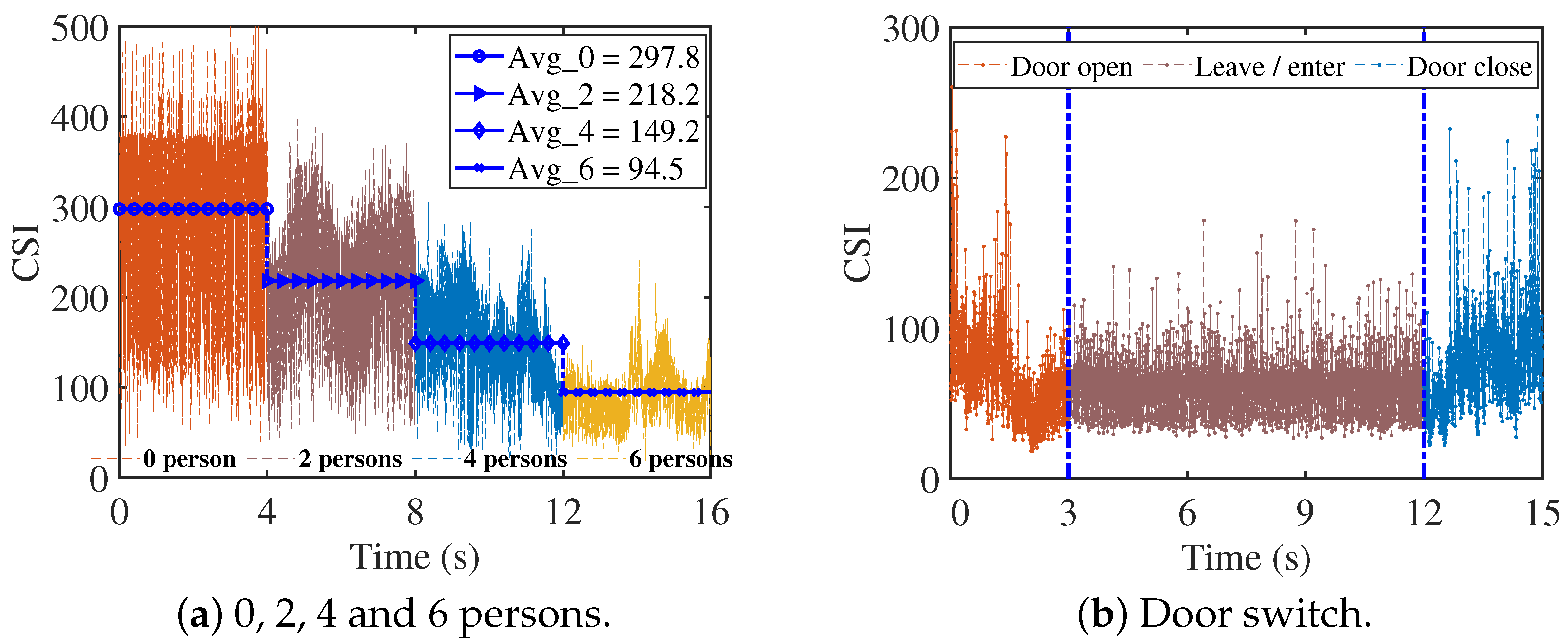
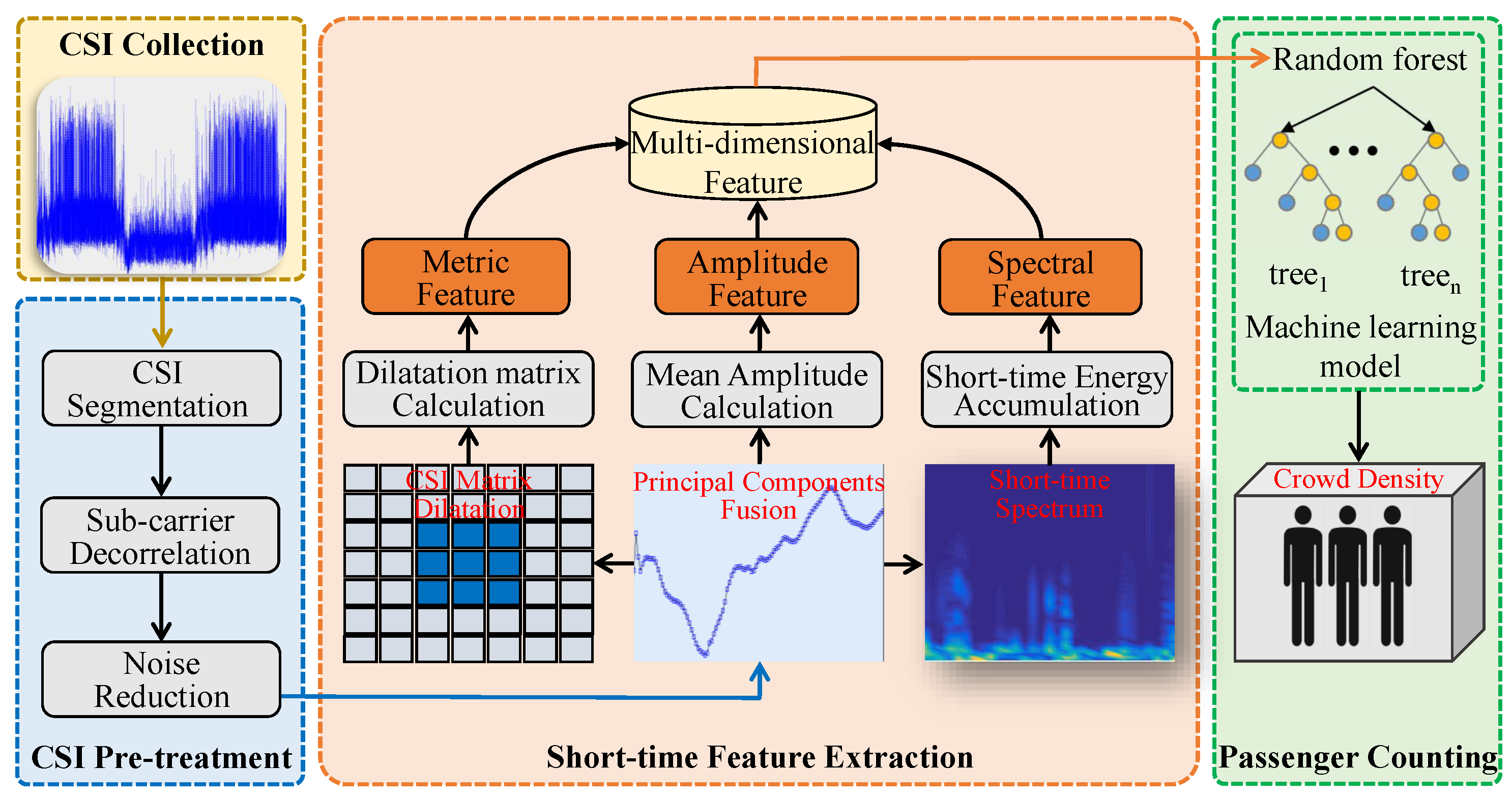
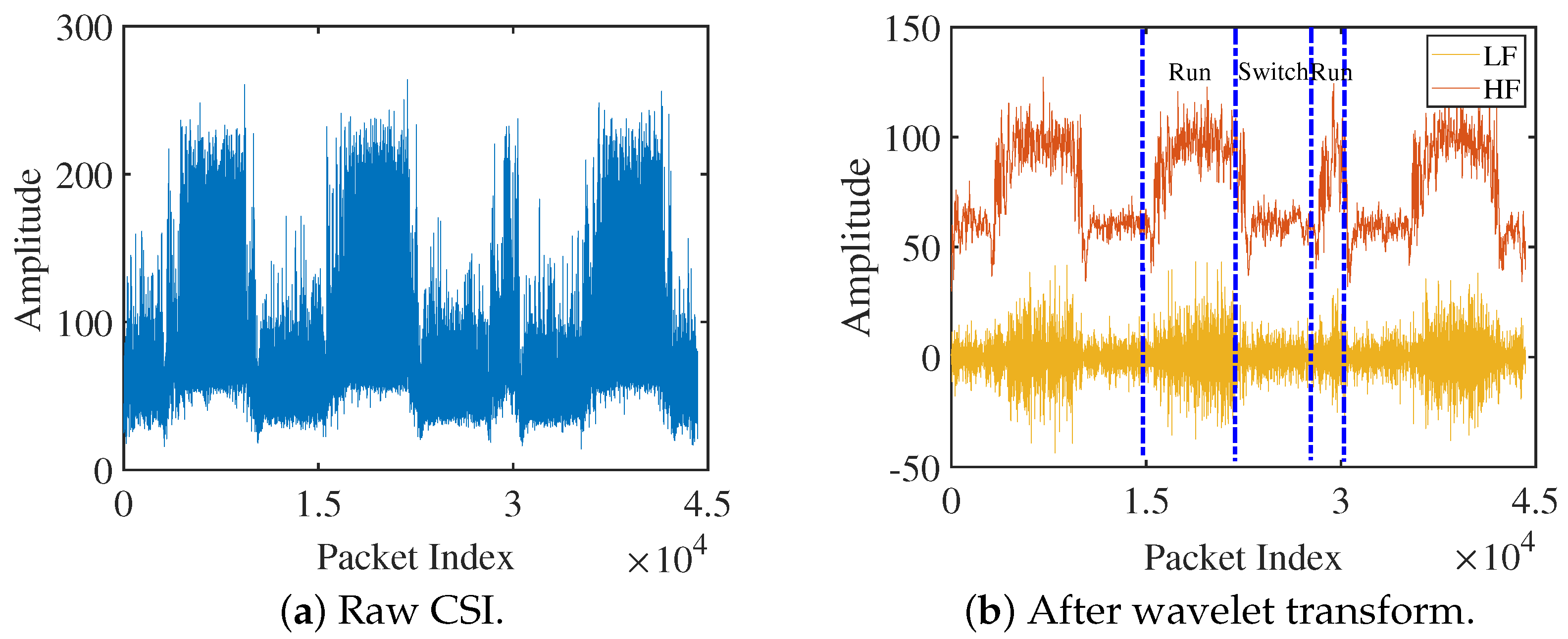
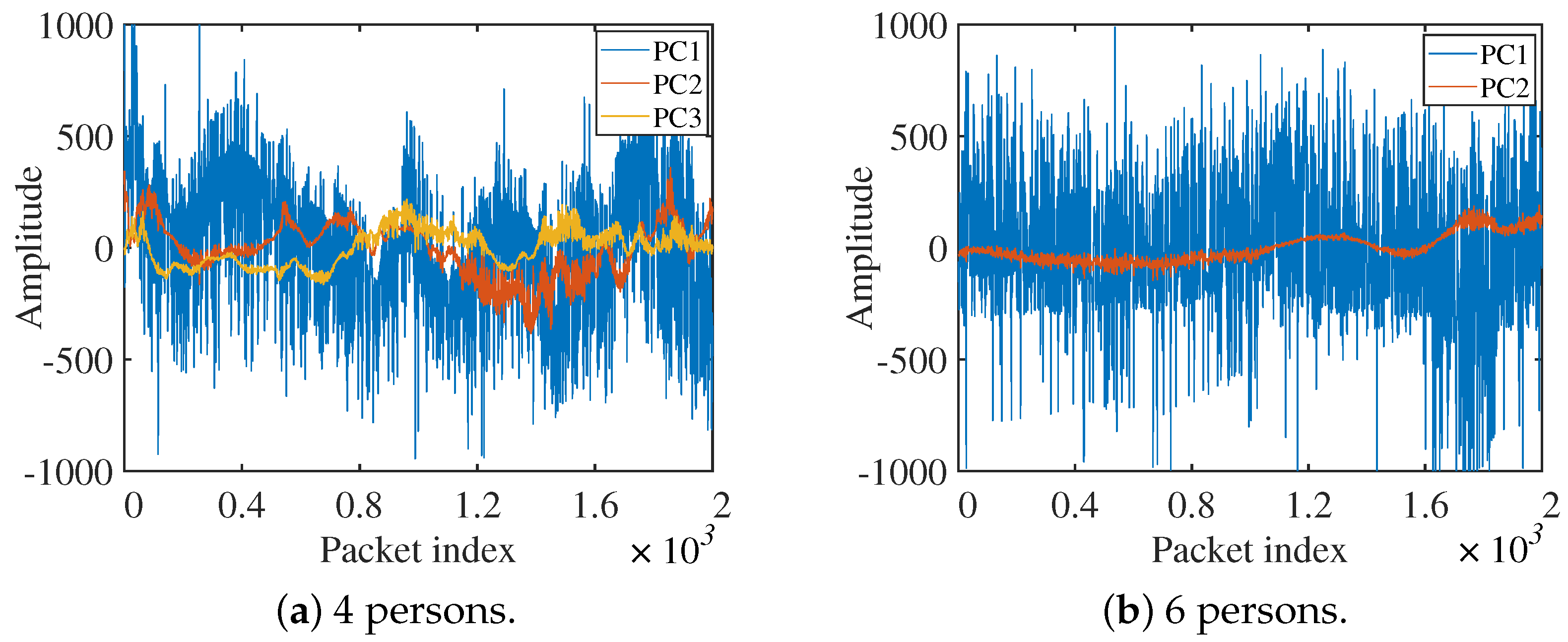
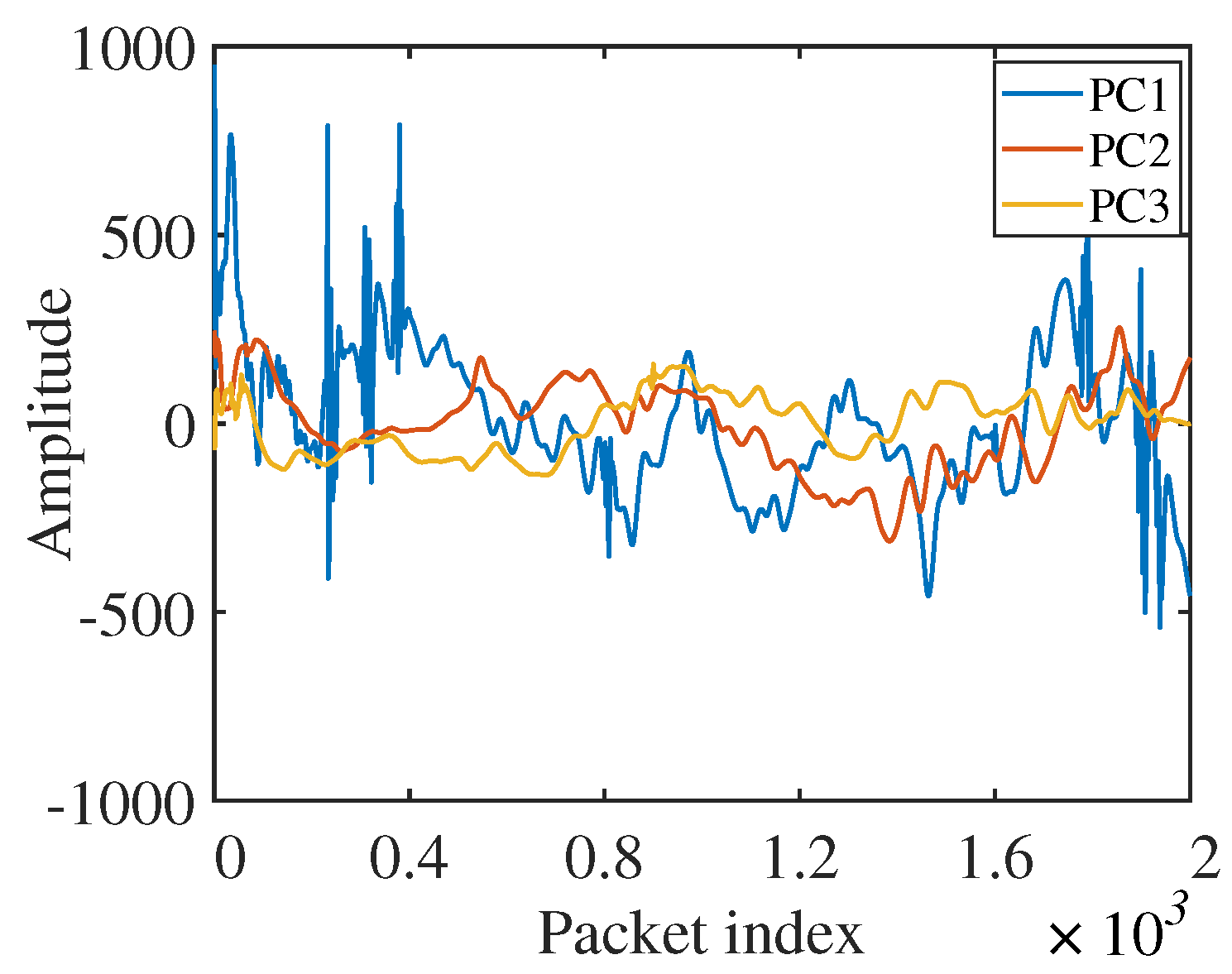

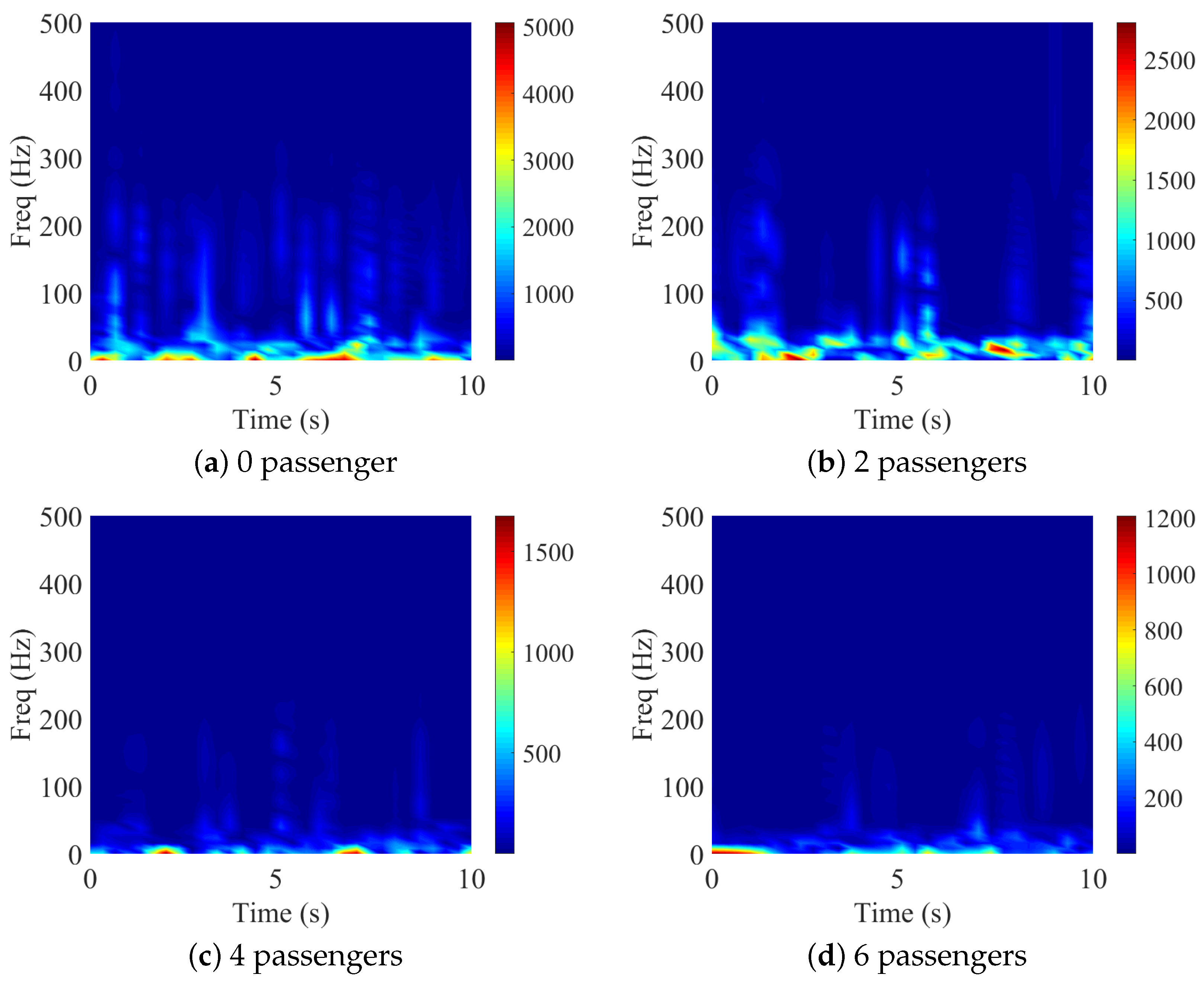


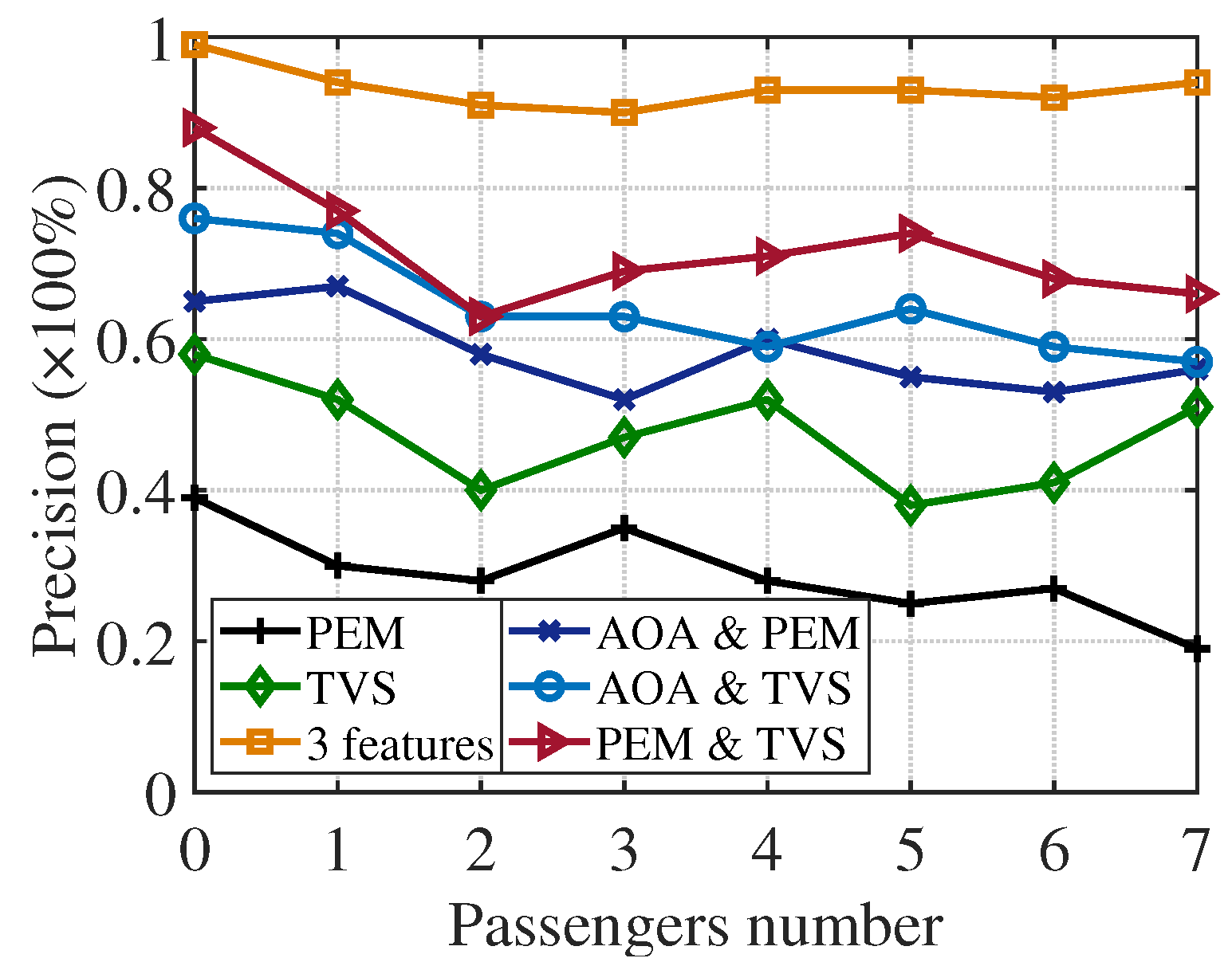
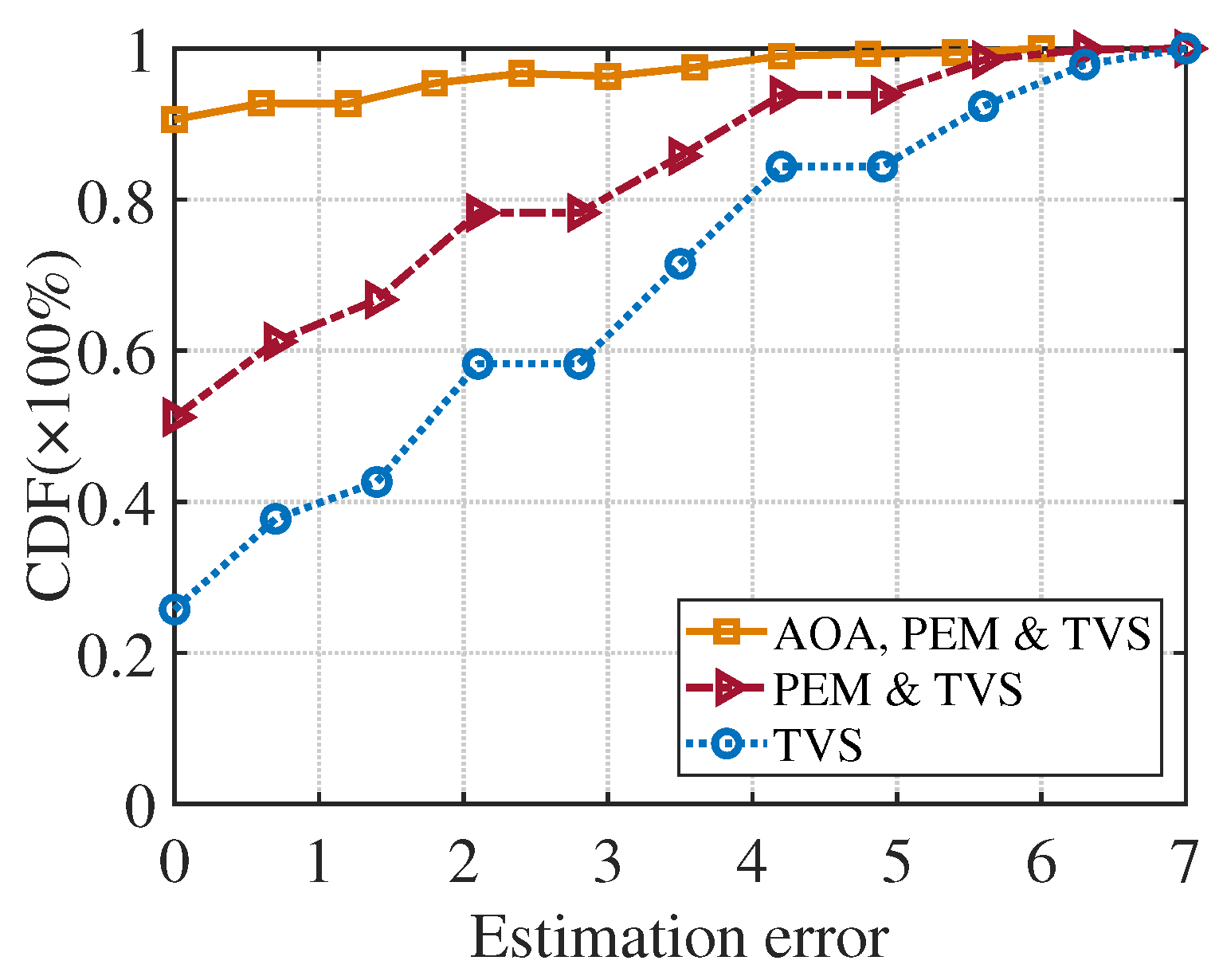

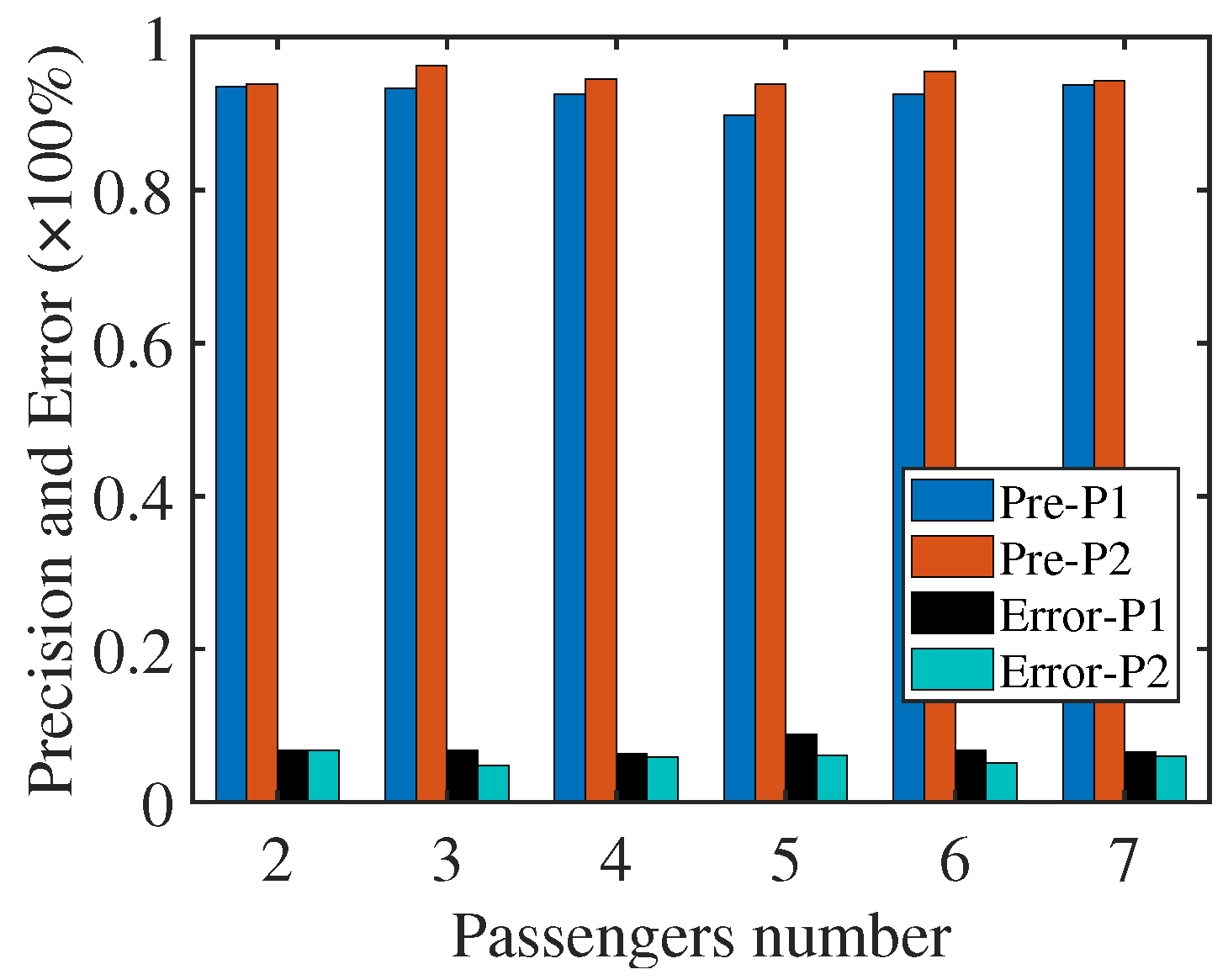


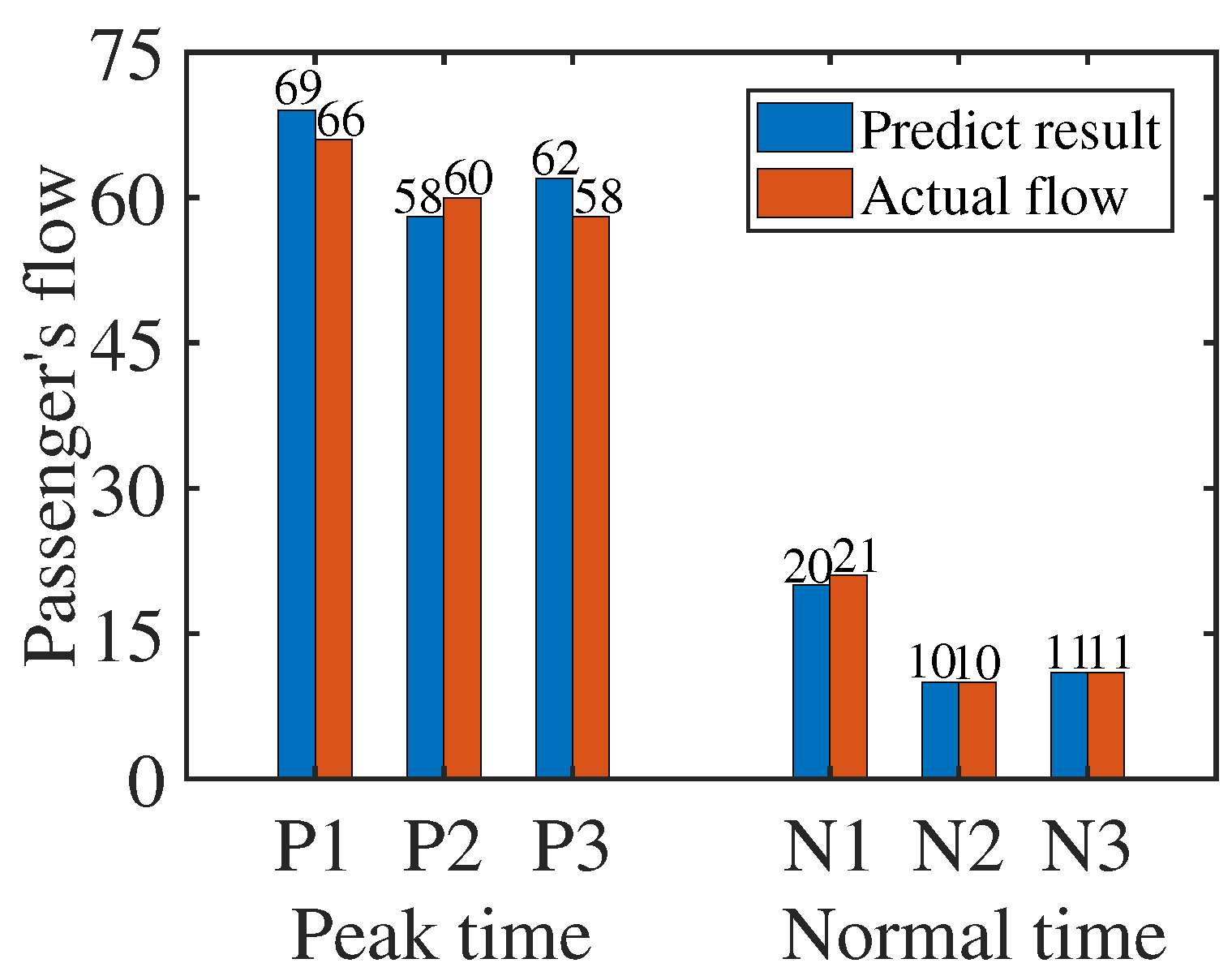
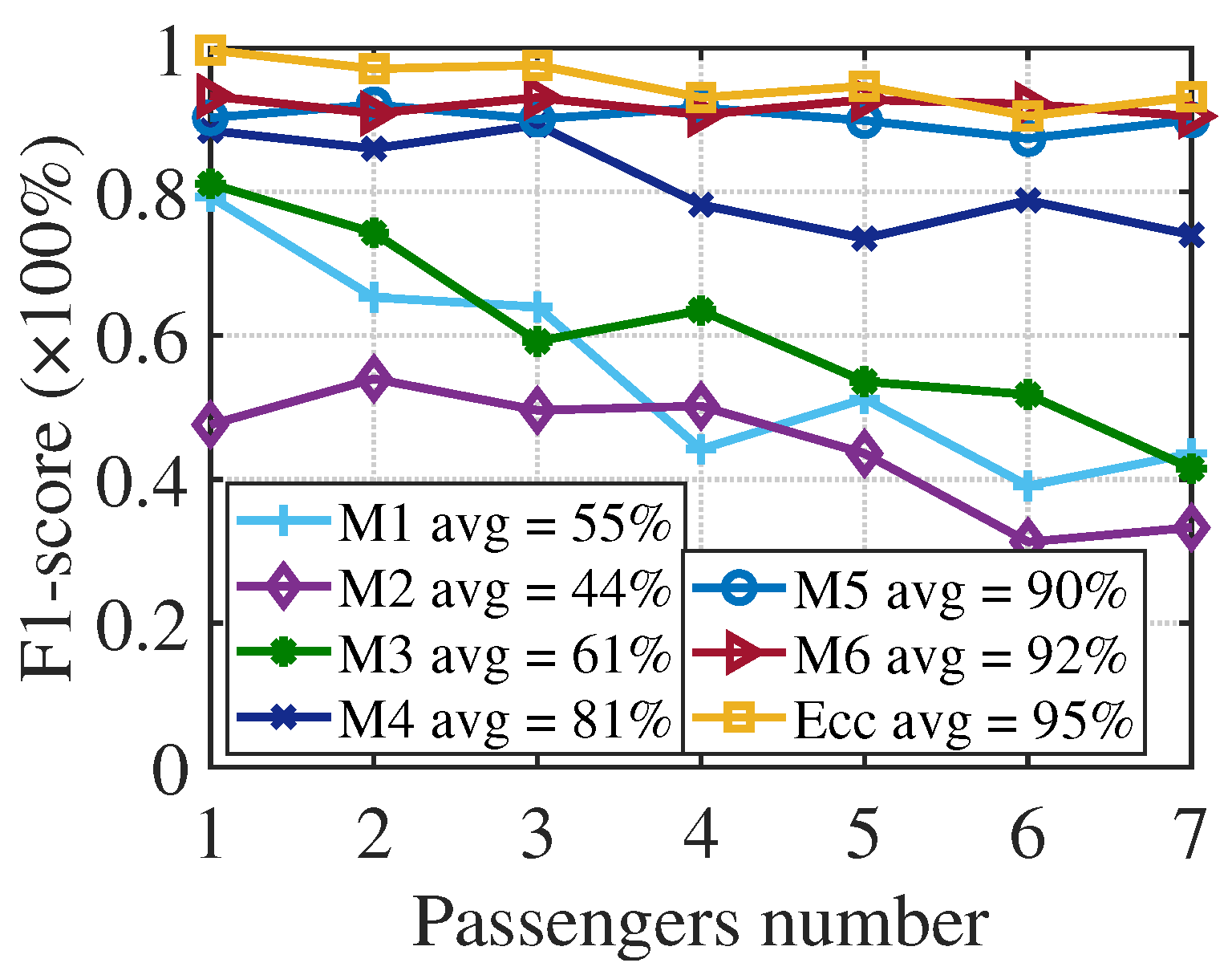
| Ref. | Environments | Standards | Classifier | Accuracy Rate | Max # of People |
|---|---|---|---|---|---|
| [25] | indoor, outdoor | D-link WBR-1310 and WLAN card | − | 20 | |
| [22] | bus | ESP8266 battery pack and SD card reader | − | 67–88% | 17 |
| [23] | indoor | TPLINK N750 | SVM-TKL | >67–99% | 7 |
| [24] | indoor | Intel 5300 NICs | Semi-supervised Learning | >90% | 15 |
| [38] | indoor | Intel 5300 NICs | SVM-Gaussian | >99% | 8 |
| [39] | indoor | ESP32 modules | RF | 77–82% | 5 |
| [40] | indoor | Intel 5300 NICs and mini R1C | Deep Learning | >82% | 5 |
| [41] | indoor | HBE-Zigbex | RF | >77% | 5 |
| ECC | elevator | Atheros 9300 NICs | RF | 15 |
| Procedure | Processing Time (s) |
|---|---|
| CSI Segmentation | 0.29 |
| Stream Selection | 0.62 |
| Noise Filtering | 0.45 |
| Feature Extraction | 1.73 |
| Passenger Counting | 0.38 |
| Total overhead | 3.47 |
Publisher’s Note: MDPI stays neutral with regard to jurisdictional claims in published maps and institutional affiliations. |
© 2022 by the authors. Licensee MDPI, Basel, Switzerland. This article is an open access article distributed under the terms and conditions of the Creative Commons Attribution (CC BY) license (https://creativecommons.org/licenses/by/4.0/).
Share and Cite
Ma, X.; Xi, W.; Chen, Z.; Hao, H.; Zhao, J. ECC: Passenger Counting in the Elevator Using Commodity WiFi. Appl. Sci. 2022, 12, 7321. https://doi.org/10.3390/app12147321
Ma X, Xi W, Chen Z, Hao H, Zhao J. ECC: Passenger Counting in the Elevator Using Commodity WiFi. Applied Sciences. 2022; 12(14):7321. https://doi.org/10.3390/app12147321
Chicago/Turabian StyleMa, Xiaoyu, Wei Xi, Zuhao Chen, Han Hao, and Jizhong Zhao. 2022. "ECC: Passenger Counting in the Elevator Using Commodity WiFi" Applied Sciences 12, no. 14: 7321. https://doi.org/10.3390/app12147321
APA StyleMa, X., Xi, W., Chen, Z., Hao, H., & Zhao, J. (2022). ECC: Passenger Counting in the Elevator Using Commodity WiFi. Applied Sciences, 12(14), 7321. https://doi.org/10.3390/app12147321






